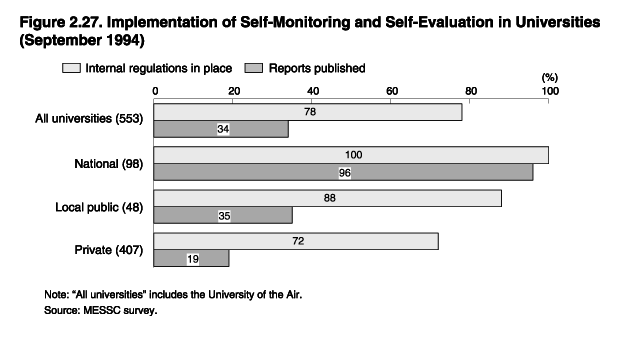| Home > Policy > White Paper, Notice, Announcement > White Paper > JAPANESE GOVERMENT POLICIES IN EDUCATION, SCIENCE, SPORTS AND CULTURE 1995 > Remaking Universities Chapter 2 Section 3 2 | ||
To revitalize and improve the quality of their educational and research activities and fulfill their responsibility to society, universities need to maintain continuous self-monitoring and self-evaluation programs and make improvements based on the findings of those programs. Although a number of universities maintained self-monitoring and self-evaluation programs in the past, the practice was not universal. As a result of the June 1991 amendment of the Standards for the Establishment of Universities, however, universities are now required to subject their educational and research activities to self-monitoring and self-evaluation.
The accelerating process of university reform since the amendment of the Standards for the Establishment of Universities has been accompanied by a rapid increase in the efforts of universities to implement self-monitoring and self-evaluation programs. As of fiscal 1994, 434 universities, or approximately 80% of all universities, had established internal regulations concerning self-monitoring and self-evaluation.
The Standards for the Establishment of Universities contain no specific provisions regarding the scope of self-monitoring and self-evaluation. In its February 1991 report titled "Improvement of University Education," however, the University Council noted that self-monitoring and self-evaluation might include such areas as
Statistics concerning the implementation of self-monitoring and self-evaluation are provided in Figure 2.27 . It is hoped that individual universities will adopt appropriate monitoring and evaluation programs on the basis of careful study that takes account of their ideals and objectives and the characteristics of their educational and research activities and that they will maintain a strong commitment to university reform.
Self-monitoring and self-evaluation are implemented to enable universities to ascertain their current situation and any problems that may exist so that they can make improvements on their own initiative. In addition, by publishing the findings of their self-monitoring and self-evaluation programs, universities can inform their communities of their circumstances and seek community input.In recent years an increasing number of universities have made the findings of their self-monitoring and self-evaluation programs available to the public in such forms as annual reports. In fiscal 1994 reports were published by 190 universitieso approximately one-third of all universities, and over 40% of the universities that had established internal regulations concerning self-monitoring and self-evaluation. The kind of information published can be divided broadly into the following three categories on the basis of differences in the perspectives from which self-monitoring and self-evaluation are implemented.


The first category includes universities that carry out comprehensive self-monitoring and self-evaluation covering all aspects of their educational and research activities at the university and faculty levels and publish the findings under such titles as "X University's Self-Monitoring and Self-Evaluation Report" or "The Current Status of and Issues Facing Y University." Many of these reports contain detailed information about the university "s history, current status and issues, trends in educational and research activities, student conditions, international exchange activities, administrative organization, and management and operational systems. A number of universities have innovative self-monitoring and self-evaluation programs. For example, some conduct questionnaire surveys of companies, graduates, current students, and others and include the findings in their reports.
Universities in this category produce reports describing faculty members" research activities and achievements and providing information about future directions in faculty research. Many universities compiled and published reports of this type even before the amendment of the Standards for the Establishment of Universities. In recent years a growing number of universities have been producing reports that are broader in scope.
In addition to comprehensive reports and reports on research achievements, some universities publish reports concerning the monitoring and evaluation of specific issues. Examples include evaluations based on questionnaire surveys of students concerning curriculum reform, surveys of adult students and others concerning the effectiveness of refresher education, and monitoring and evaluation of aspects of student lifestyles, including health management, library use, and the conditions of foreign students.
Carrying out self-monitoring and self-evaluation and publishing the findings are not the end of the process. Such efforts should be seen, rather, as an important first step on the path to new university reforms. To realize the true aims of self-monitoring and self-evaluation, universities must make renewed efforts toward university reform after carefully studying the feasibility of the steps indicated by their findings and outside response to their published reports.
In recent years there has been a growing trend toward self-monitoring and self-evaluation among Japan"s universities, and many reports have been published. The next step will be the implementation of concrete university reforms based on the results of self-monitoring and self-evaluation.
| Back to Top | MEXT HOME |